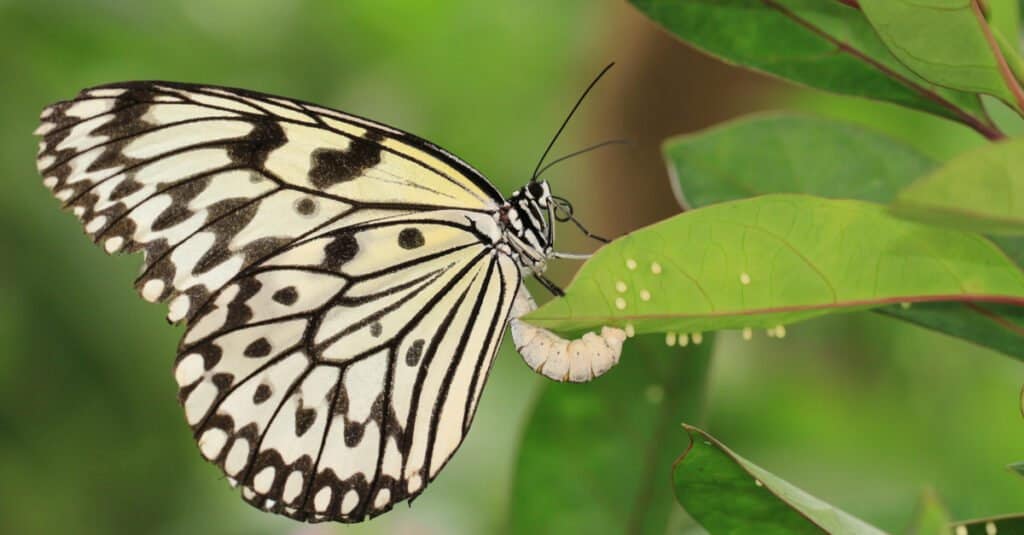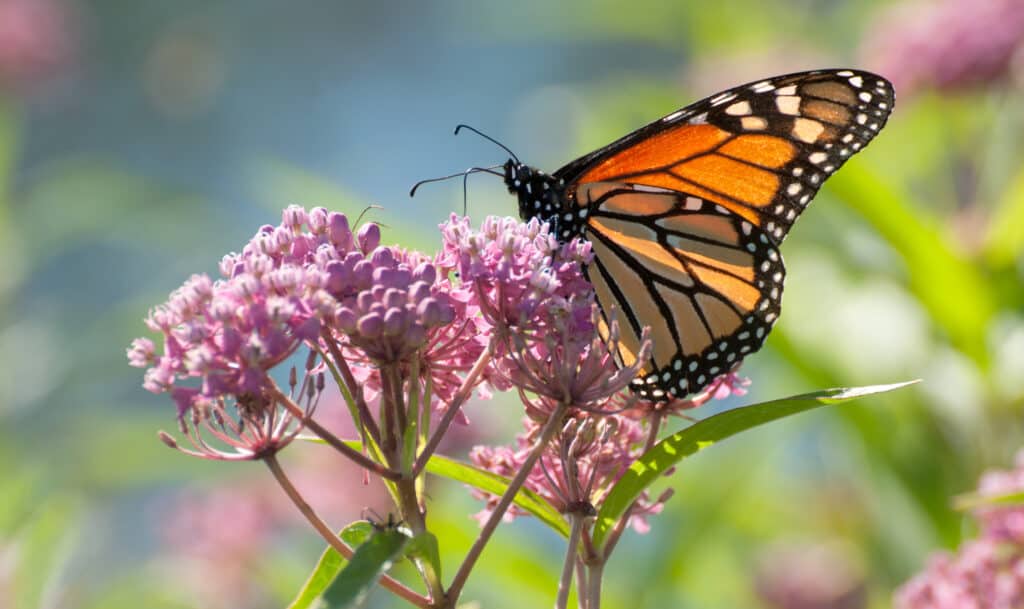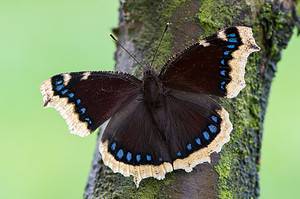As unfortunate as it may be, the population of monarch butterflies is steadily declining. As a result, quite a few dedicated gardeners have taken it upon themselves to produce the necessary milkweed plants to aid in their efforts to reproduce. However, there’s one problem, the pesky aphids. Aphids can appear on many plants, and milkweeds are no exception. While you want to do whatever possible to rid yourself of these troublesome pests, you also want to preserve any developing butterflies. So, you have to carefully put your knowledge of butterfly eggs vs. aphids to the test.
In this article, we will explain how to visually differentiate these two tiny spheres. Once you understand what you see, you’ll be able to use that knowledge to help you proceed. We also provide you with actionable tips for how you can move forward.
Identifying Butterfly Eggs vs. Aphids

To avoid harming the precious butterfly eggs, it’s important to learn how to distinguish them from aphids.
©happykamill/Shutterstock.com
To learn how to tell butterfly eggs and aphids apart, it’s important that we take a close and analytical look at them both. Here butterfly eggs vs. aphids are broken apart into three distinct categories. Once you have these down pat, you should be able to identify whether it’s an egg or a problem with aphids in no time at all.
Physical Appearance
People get tripped up due to size when it comes to the physical appearance of a butterfly egg or aphid. You see, both are incredibly small. It’s hard to identify them based on size alone, so you must turn to other characteristics, such as color.
Monarch eggs will appear either white, or a slightly off-white yellow. Aphids, on the other hand, have a much wider range. They can be their typical bright green-yellow tone, or they can even be red or brown in some instances. Most importantly, though tiny, aphids possess legs. You could probably guess this, but butterfly eggs aren’t exactly crawling around. If you manage to spot their tiny limbs, you know that they’re aphids.
Texture
At a glance, both aphids and butterfly eggs have the same smooth texture and circular shape. However, if you take a closer look with a magnifying glass, you’ll notice that there are slight ridges and patterns along butterfly eggs. Aphids, on the other hand, are usually a bit waxy looking due to the fluids they secrete.
Location
Initially, this can be a bit tough. That’s because both butterfly eggs and aphids can be found in the same part of the plant: the underside of leaves. However, what makes a difference is why they choose this location. While butterfly eggs are on the undersides of leaves to avoid predators, aphids gather there because it’s the area on the plant that makes sap most accessible.
The biggest indicator that you have aphids on your hands is quantity. Despite not being social creatures, aphids are nearly always gathered in large clusters. They densely pack themselves along the stems, almost in a huddle. Meanwhile, butterfly eggs will be placed individually, apart from one another. So, if you find singular or sporadically-placed spheres, then it’s likely that they’re butterfly eggs.
The Importance of Keeping Butterfly Eggs Safe

The monarch butterfly is an insect that, while a once-common species, is now near endangerment.
©iStock.com/SherryL18
Now that we’ve established the differences between butterfly eggs vs. aphids, now it’s time for the important bit. Why should you care about butterfly eggs? The sad fact is that the monarch butterfly population has declined by 85% over the past two decades. Their populations are lower than half of what is necessary to avoid extinction. However, monarchs are important pollinators. That is why, as trivial as it may seem, saving as many of these beautiful butterflies as possible is entirely necessary.
These butterflies face multiple threats, for example, pesticides like herbicides, urban development, and climate change, to name a few. Although national governmental intervention is needed at this point in their endangerment, every butterfly counts. Protecting and preserving these eggs and ensuring that they see adulthood is an individual act of kindness that nature will be grateful for in the long run. Not to mention, who doesn’t enjoy seeing butterflies flying around their garden?
The Role That Milkweed Plays

Popular with both aphids and butterflies, milkweed is a simple plant to grow, adding color to your garden.
©Nancy Bauer/Shutterstock.com
Milkweed is critical in the survival of monarch butterflies; it is the sole host plant for monarch caterpillars and provides the essential nutrients required for their development. The lifestyle of this insect intertwines with this plant, so its growth and availability are crucial. However, due to habitat destruction, natively grown milkweed has declined dramatically. This is another blow to the already decreasing monarch population.
However, while milkweed is essential, it is also quite simple to grow. There are very few specifics that come with growing this plant in your garden, should you choose to. Milkweed serves as the feeding ground for the monarch caterpillars and is also where female monarchs lay their eggs. The loss of milkweed means a loss of breeding and feeding grounds. Therefore, a solid effort to plant more milkweed can be a practical step in rebuilding monarch butterflies’ habitat and food source.
Destroying Aphids Without Harming Butterfly Eggs

While it’s important to get rid of aphids for the health of your plant, you don’t want to harm any butterfly eggs in the process.
©iStock.com/Wirestock
As we’ve demonstrated with the reiteration of their declining populations, it’s essential that you keep any present butterfly eggs safe. That said, it’s understandable to not want aphids on your plants. Aphids take essential resources from your plants, diminishing their growth. In extreme cases, your plants could die. Since milkweed is vital, you don’t want this to happen!
The concern is how to get rid of aphids without harming butterfly eggs, too. Traditional pesticides, even things like soap and water, could kill the eggs. Luckily, this is an issue many home gardeners face. As a result, there are a few viable options you can try.
Use Biological Control
There are plenty of creatures out there that dislike aphids just as much as you do. These creatures, luckily, don’t share the same interest in harming butterflies or their eggs. So, if you deliberately introduce some of these things, you could resolve the problem without excessive intervention. Some of these predators include ladybugs and lacewings, and also potentially parasitic wasps (though you probably wouldn’t want those around for your own sake).
You could install some bird feeders or birdhouses near your milkweed, but this might be counterproductive, as our feathered friends don’t exactly discriminate when it comes to what kind of insect they’d like to make a meal.
Try Some Natural Methods
Several organic options on the market can help with removing aphids. There’s a natural pesticide called neem oil, for instance, that affects aphids but generally doesn’t cause harm to butterfly eggs. You could also take some diatomaceous earth or reflective mulch and put it near the base of the plants, which will deter aphids from laying there.
You can also try using ant deterrents. Ants and aphids have a natural protective relationship, and by disrupting this relationship, you could control the populations of aphids indirectly.
Getting Down and Dirty
here are more glamorous methods than this, but sometimes it proves necessary. Once you can differentiate between butterfly eggs vs. aphids visually, there’s no reason why you can’t physically remove the aphids on your own. Hand-picking isn’t preferable, but it is effective. At the end of the day, the method doesn’t matter as much as the results!
The photo featured at the top of this post is ©
Thank you for reading! Have some feedback for us? Contact the AZ Animals editorial team.






